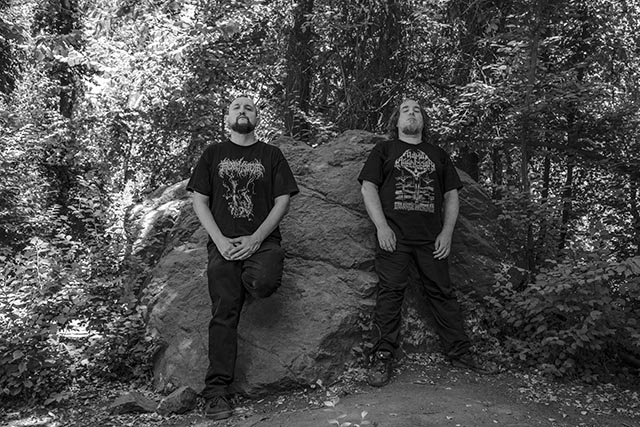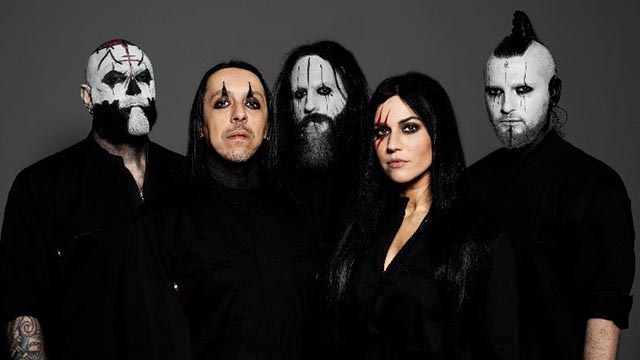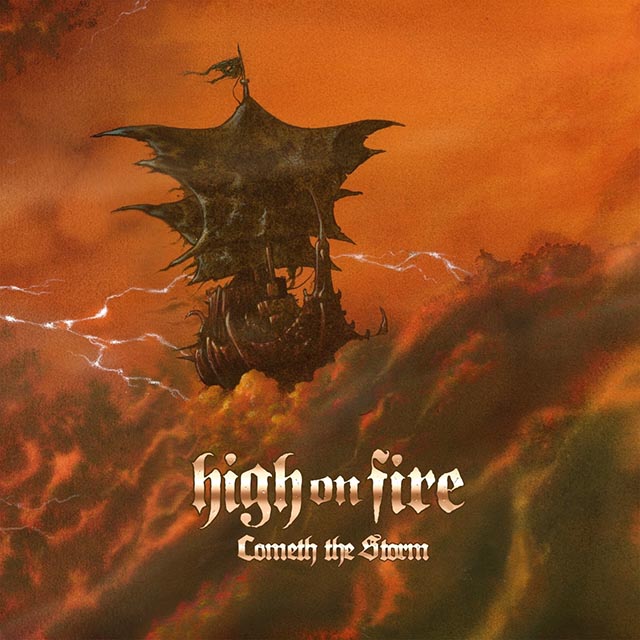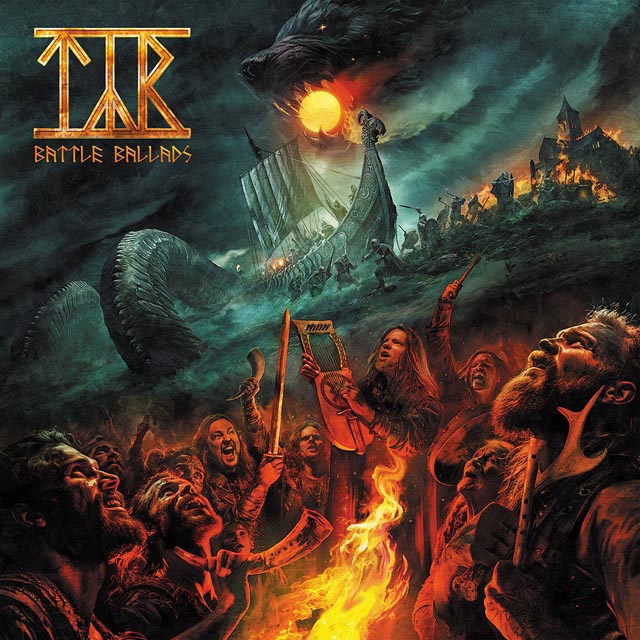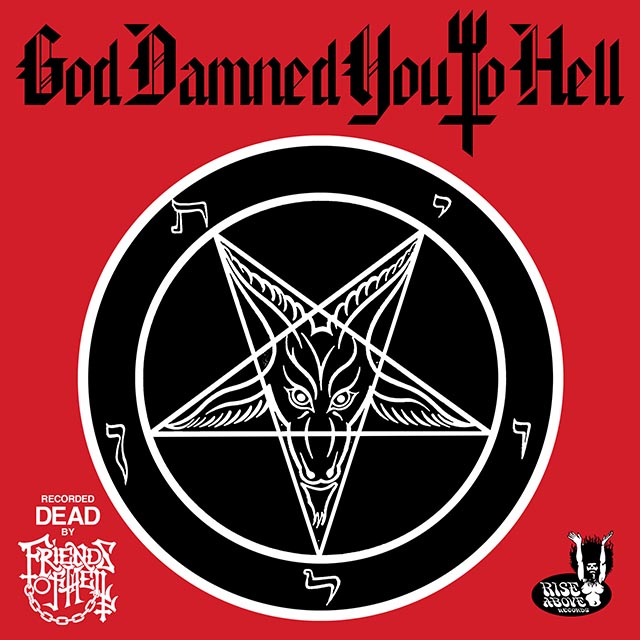 When you see piece of artwork by Thomas Hooper, be it a tattoo, a painting or one of the limited number of album covers (Tombs, Doomriders, Scott Kelly) that he has done, it bears an unmistakable mark of quality. You can stare at his work for hours, return a few days later and pick up something completely new. Words like “sublime” come to mind.
When you see piece of artwork by Thomas Hooper, be it a tattoo, a painting or one of the limited number of album covers (Tombs, Doomriders, Scott Kelly) that he has done, it bears an unmistakable mark of quality. You can stare at his work for hours, return a few days later and pick up something completely new. Words like “sublime” come to mind.
You have the sense that there are feelings and higher concepts woven into the fabric of the work, it’s not just decoration, like so much of what passes for “creativity” or “art” is in this disposable age. It hints are a more workmanlike approach that has more in common with an artisan than an artist, yet there is so much more. Spirituality? Maybe, but the impact of Hooper’s work is undeniable.
I had the opportunity to meet up with the Sidley, UK native in his Brooklyn studio to talk about his work, new projects and the meaning of fatherhood.
What came first for you, tattooing or painting?
Tattooing. My mother was an artist and I grew up loving art. She had a studio at home and was always creating art, and I was very inspired by that. My father played music, when I turned 14 or 15, I decided to do neither; it wasn’t a mistake but it stopped me for a bit. If I had done it from that age I would be five years ahead right now. Different paths: I studied mechanical engineering for two years and learned about design.
I just couldn’t get on; I wasn’t good at math. When we got to complex numbers and stresses on helicopter blades and stuff like that, it was beyond me. But I enjoyed the technical drawing and being creative. I enjoyed having that object and that idea in your mind and making it into this tangible thing.
You worked as a machinist for a while; do you think engineering and your experiences as a machinist influenced your work?
Definitely. I think I’m at this stage where I have these different tools and bits of language that are in my art where I don’t fully understand them quite yet. I’m still learning about which ones appeal to me and I’ll have to sit down and further fully understand why they relate to me. I kind of just allow myself to be naturally drawn to things. But I think the draw to wanting to be an engineer and make things is the same as wanting to paint and create on paper and such.
I did the engineering, was lost, didn’t know what to do. Took a year off, worked in the engineering field and hated it. I had friends doing it and I could see if I stuck with this in two years I could be making more money. But I just can’t do 9-5; I grew up listening to punk music. Just didn’t work for me. I worked listening to punk rock on my headphones in a place where you’re asked to not show initiative. When I left engineering, I traveled America a bit, riding my bike. I was really into photography. So my mother said “Oh, why don’t you explore art again?” She knew she didn’t want to push the drawing/art thing, so she encouraged me to go and study photography. So I did that through a media studies course. I studied film, photography and graphic design and magazine production type stuff. That was great; I wanted to be a photographer for a minute. I really wanted to be a cinematographer; but I didn’t want to be a runner on a film set, or an assistant photographer for ten years, it just wasn’t appealing.
Then my mother encouraged me further to study in the Art Foundation, just to learn all the aspects of art. At that point, I started getting tattooed and wanted to learn that craft, and the two kind of melded together. I met William Green, who was the father of a close friend. William had been a famous painter from the fifties and sixties in England. He wanted me to meet him because I was into art. We got along and I started photographing his home and his art practice. He did these dark and very destroyed and broken down type things. Then I started to learn to tattoo and went to school and got a degree in drawing.
What was the inspiration for the Origins of Solitude series, which was shown at Nepenthes in New York City?
I had no restriction because the show was at a clothing store instead of a fine art gallery so I could do whatever I wanted. I was very interested in repeating patterns, hexahedrons and honeycombs, touching on nature and how things are built in the natural world. Then I find great beauty in the chance and immediate nature of creating in abstract pieces. But they sometimes don’t have the weight to stand on their own. So I thought to mix the two and see where it gets me. I just kind of keep pushing and letting each piece feed itself, and a lot of it’s to do with decay and breakdown of the machine that is the human race. Whether we’re evolving into something great or slowly falling apart, it’s yet to be seen depending on what paths we take. The title came from the Japanese painter Shuzo Takiguchi. He was a poet, a filmmaker and a painter and did this series of paintings called decalcomania, where you paint on a piece of glass, lay down a piece of paper, peel it off and you get this abstract shape which also has this fractalization through things being peeled off; as they get peeled off they have these crystalline structures. He has a piece called Origin of Solitude, so I just played with that for the title of the show and what that meant for me, the concept of solitude.
It addresses the idea that no matter what, inside our heads, we’re on our own. Our consciousness is completely solitary. The more we surround ourselves with different things we distract ourselves from not being in the moment just there. Inside your head, it’s just vast. It’s funny: when I was 18 there was an intro on this Neurosis song that just kind of stuck with me. It was “your mind is as vast as the universe…”And it is, you can imagine anything, and then nothing. Then when you’re dead, that infinite space is gone. All this infinite space is held in this tiny object, which is you’re skull.
There’s also the concept that our brains are receivers and our consciousness is this energy field, and we’re receiving information from a vaster pool of energy.
Of course, but there is so much individuality to each person. You see that more apparent when you look at people who are just trapped in hell. And they’re here in the same plain of existence as we are and it’s just awful for them for whatever reason or mindset, and they’re trapped in it.
Yeah, like reality being completely subjective and consciousness being completely subjective. Do you believe in the karmic cycle where people are destined to relive these cycles in their lives until they get them correct and then they move onward?
I think so. There are reasons people are drawn to things without knowing. There are reasons you keep doing things or revisiting things. A reason for when you pick something up and you know you’ve seen it before or it feels right, or I feel I should understand it but I don’t yet. Or if you look at true geniuses, like Einstein, Mozart, Beethoven, etc., what they achieved in their lifetime so young. If Beethoven never played music before in his life could he have really done all of that so quickly in any of his lifetimes?
How has the birth of your son influenced your creative life?
It’s an awakening experience. You see the beauty of life and the fragility of it. It brings in new fear. I was never fearful of my mortality, but now I realize that my mortality, for the next eighteen years, it will add to his ability to survive. Having a son gave me a purpose. There’s more of a reason now then there was before when it was just a pursuit of “hey look at me” or the reasons I was doing it before were, so I could call my mom and say “look mom, look at me”. But now it’s like “All right, I’ll go make some shit so I can put some food on the table and save up so my son can have the best life I can provide for him.”
Any creative form of self expression is extremely narcissistic; I’ve always struggled with that, but now it’s like “Ok now, I need to be successful so I can provide a future for my son.” So it gives me a great reason for all of that and brings in all sorts of new fears and ideas about mortality.
You have some art books available;The Book of Skulls and The Book of Lines; what is the story behind these?
They were never intended to be what they are. I have always enjoyed drawing skulls and they have always played a lot in my tattoos. When I was in college, one of my teachers had a human skull and I photographed it so that I could draw from it because I didn’t have a real one at home, and I didn’t want to spend a bunch of money on a plastic one. I wanted to see the real deal, see the broken down textures. I have never been a fan of that replicated stuff because I wanted it to be more real on the skin, especially with tattooing, I can sit and do a life drawing of a skull and study it for five hours, so having photographs in hand, I can trace out the base or anatomical structure and redraw into it and make it quick. So I was doing that and I knew I needed more. I couldn’t keep using the same five photographs. So I took a few more and they were ok. Some friends wanted them, so I made this sort of low end ring bound thing.
People were interested in it, I photographed them as professionally and then made it into a book so I could have one at work and sell a few. And then two years later, it still sells a handful of copies every month, which is fantastic. I’m actually moving onto the next stage. I’m going to re-photograph it all. The original books were expensive to make and expensive to sell, so I’m going to make a better quality one with all new pictures that is cheaper but better. It’s just like a copyright free resource because it’s not something I should be too attached to, but let people use it.
The Book of Lines, I wanted to make myself create some new patterns. In tattooing, it’s a thing called a sketchbook with symbols and a bunch of tracings and outlines you’ve done for tattoos that haven’t necessarily become tattoos due to people not showing up or not being into the designs. They all go into the book or get traded with friends. I decided to do that with the patterns and drawings I create. Again, it just kind of blew up and keeps getting bought by people, which is amazing. There was never like “Oh ok, I want to publish a book,” but was more like “Oh look, I can make this through this website and it will be better then spiral binding it.” And then I thought maybe I should make a venue for me to publish books and then to publish my friend’s books. I can do a low budget but high end product fine art publishing company.
This is Artifact Publishing?
Yes. It’s going to basically be that. It’s going to function like it was a fine art gallery that made books, but there’s no gallery. It’s basically giving a forum for myself and my two partners. If we make a company that basically pays for itself then whoever works hard on creating and running it, which will probably be Ryan [Begley, partner in Artifact Publishing], they’ll draw a wage. So it kind of is paid for and it’s not making a profit, but it’s running itself like a good small tight ship. We can give artists that we want to help a better deal and put more money in the hands of the people that make the art.
The company is myself, Ryan Begley from Shirts & Destroy and Chris O’Donnell, who is one of the co-owners of and runs Saved, the tattoo shop that I work at. It’s just taking control and making something. I read this interview with Cormac McCarthy in the Wall Street Journal where he was talking about how there is so much of everything these days. Like the famous Greek plays, we don’t have ten thousand of them that are mediocre. We have three because only the good ones survive. These days, anyone can make something and put it out there. before, it was made because it was something special. So we’re trying to do that. That’s where the name comes from, to make some kind of Artifact. Like “Look, this is some substantial thing, not just something flimsy and crappy. This is evidence of that thing having existed.”
We all have a busy schedule, so we keep it quite loose. The first product was this box of these strange, abstract screen prints I made. That was phenomenal, it sold really well. Ryan did all these handcrafted wooden boxes with these 28 silkscreen prints. We keep all the editions quite small. I had two prints, I only have one of them now. When my exhibition comes down, I’ll put some originals up. Chris O’Donnell is going to put some originals up soon and then we’re going to start bringing other artists onto the roster. I think two of the first people are going to be Dave Cook, who has done a bunch of artwork for Young Widows, that weird skull thing. He draws this stuff by hand, it’s just amazing. So we’re going to put some of his originals up. And I’m going to come up with this print series where we take an artist and we’ll ask them for ten or twenty originals that are all similar. Just drawn on paper, that isn’t necessarily a piece of art that can be sold on its own for a decent amount of money. We’ll take them and well put them in a little box or slipcase and they’ll come with three prints. A silk screen print, a digital print and then like another kind of print, a mixture of the two, a laser etched print or something like that. So you’re buying this thing and your getting the original and then these three other elements, like a selection of things but they only come in that packet. So I’d like that to be a series.
I’m working on a follow up to my Book of Lines, called Book of Patterns. I’m basically going to create five hundred patterns that repeat, full bleed. Then I’m going to edit it down a bit and then just make a book of just patterns. Like anything you might get in Dover Book Shop, Copyright free. Chris is doing a book of drawing studies for the way he draws and tattoos. I have unconfirmed projects that I want to do with many different artists. One of which is a box of prints I did for the Winter solstice, I want to do one that is around Spring and Easter with a man named Robert Ryan which will be like a mixture of Hindu art crossed with Dutch art. Then I want to do a book on Seldon Hunt and basically a monograph of him because he’s been making art for twenty something years. Pelican are slowing down, Sunn O))) and Isis is gone; those are the three main bands he did art for and people emulate. That era for him has passed, so I want to mark that career. You still see him getting ripped off when you walk into Urban Outfitters and see a shirt with two mirrored birds and a mirrored tree and you say “Did Seldon do a shirt for Urban?” No, someone went onto his website and ripped him off and I just want to mark it. And with bands I work with or bands I like who put out a record that is really substantial or something I really enjoy, we’ll ask them for fifty copies and deconstruct the packaging and recreate it as something totally different and individualized.
All the books we do we’re going to treat them like editions, like LPs since we’re going to make the covers ourselves. I’ll do five hundred for my new Book of Skulls. There will be 10 artist copies with a white cloth cover, fifty of the brown cover, one hundred with a black cover and the rest will be soft cover. So it’s something more than just being on Amazon.
You don’t do too many album covers; your next thing is the new Scott Kelly record.
I’m super fortunate to work with Scott. It’s going to look like a classic jazz record. I’ve tried to limit the album artwork to a few so I can keep it interesting because they are not a substantial part of my income. I’m fortunate to not have to be an artist in the music world to pay my bills. It helps but I can do it for the love of the music. But what I’ve been doing lately, I’m finishing Scott’s thing up and then another band’s record to do.
I’ll keep it to a minimum so I can make them good and not be repeating and churning things out. I try to make it somewhat different and evolve each time. Rather than thinking: “That’s my style, I’m going to make it all look like that.” I understand that; it’s what I do with my tattoo work.
I was talking to Scott, he was just in town playing a show and he thanked me for the art. And I said it was an honor, not to be a nerdy fan boy or a kiss ass, but I was 17 at college listening to Neurosis making art and now I’m listening to a member of Neurosis making art for him; which for me is phenomenal.


